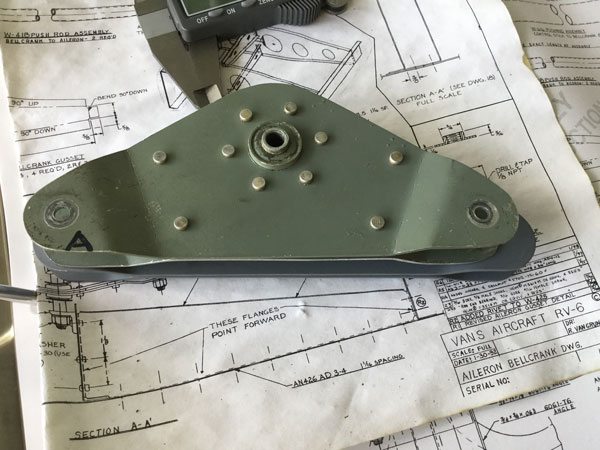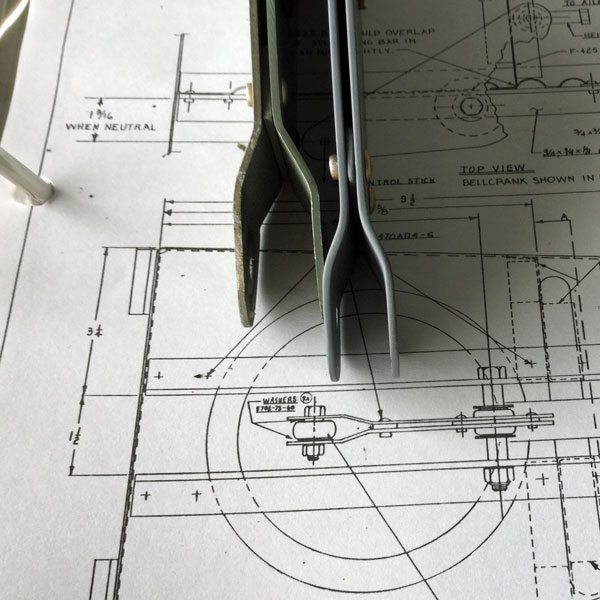catmandu
Well Known Member
In the process of complying with the aileron hinge bracket SB on my purchased RV-6A, I happened to notice my deflections were 'not quite right', one aileron moving several degrees more than the other in total travel. I started running through the control system, and came to discover the aileron bell cranks were not manufactured according to plans.
After much thought and consultation with mechanics, community members, and the factory, I determined that, while not right, things were safe for flight. This decision was bolstered by the fact that my pink slip is twenty years old, many a conditional inspection has been performed, and many pilots have flown the aircraft and not noticed anything amiss (Other than I always thought aileron rolls one way were a bit snappy compared to the other, but figured my big fat butt in the left seat was the culprit).
I did, however, want to make things right. So I purchased the proper bell crank parts from Vans, did my first bit of building (using real rivets, not those pop-things), and found myself with two new, properly sized bell cranks.
Upon returning from OSH, I went about installing these newly made parts and looking at the required changes to the rigging. Come to find out, no amount of rod end adjustment was going to get me anywhere near the installation orientation shown in the plans.
Decision time: make it work, or make it right? I do need to make a trip this weekend to check on a business venture . . .
<sigh>
Plane is down for a while, a FedEx truckload of parts (that started as two new properly sized push rods to the control stick, and ended with all new hardware end to end) is on its way across the country.
There is a responsibility that comes with the ability to perform your own maintenance, and we need to remember it is a privilege, not a right. This, I believe, is especially true for wide-eyed relatively new owners like myself who are still enamored with the incredible options available to us in the experimental community.
In the end, $300 worth of hardware and tubing is not much of a price to pay for the privilege to be able to perform my own maintenance, and in the process learn a little bit more. After all, isn't part of homebuilding education?
Guess I have a few days to start working on installing those Sam James wheel pants. Fiberglass work, Yipee!
After much thought and consultation with mechanics, community members, and the factory, I determined that, while not right, things were safe for flight. This decision was bolstered by the fact that my pink slip is twenty years old, many a conditional inspection has been performed, and many pilots have flown the aircraft and not noticed anything amiss (Other than I always thought aileron rolls one way were a bit snappy compared to the other, but figured my big fat butt in the left seat was the culprit).
I did, however, want to make things right. So I purchased the proper bell crank parts from Vans, did my first bit of building (using real rivets, not those pop-things), and found myself with two new, properly sized bell cranks.
Upon returning from OSH, I went about installing these newly made parts and looking at the required changes to the rigging. Come to find out, no amount of rod end adjustment was going to get me anywhere near the installation orientation shown in the plans.
Decision time: make it work, or make it right? I do need to make a trip this weekend to check on a business venture . . .
<sigh>
Plane is down for a while, a FedEx truckload of parts (that started as two new properly sized push rods to the control stick, and ended with all new hardware end to end) is on its way across the country.
There is a responsibility that comes with the ability to perform your own maintenance, and we need to remember it is a privilege, not a right. This, I believe, is especially true for wide-eyed relatively new owners like myself who are still enamored with the incredible options available to us in the experimental community.
In the end, $300 worth of hardware and tubing is not much of a price to pay for the privilege to be able to perform my own maintenance, and in the process learn a little bit more. After all, isn't part of homebuilding education?
Guess I have a few days to start working on installing those Sam James wheel pants. Fiberglass work, Yipee!
Last edited:






